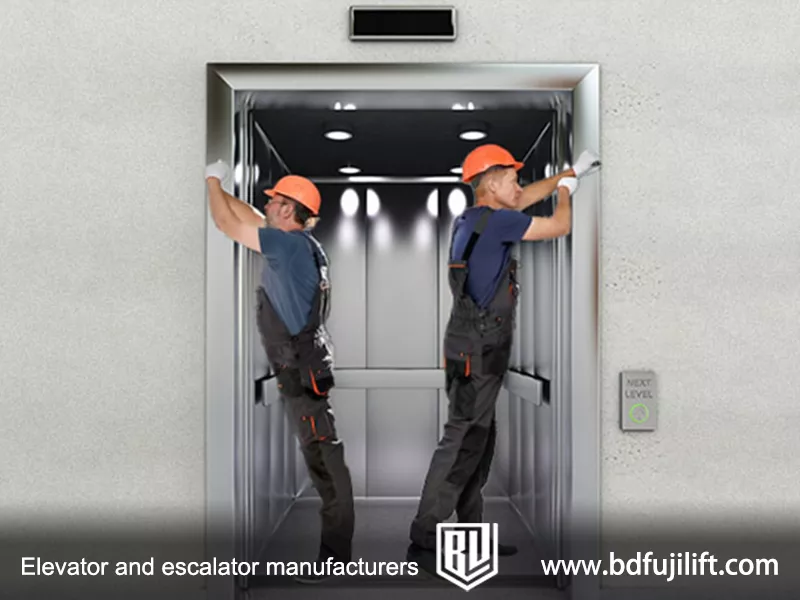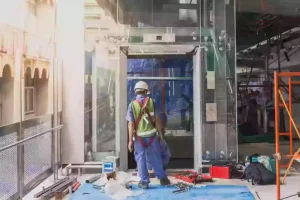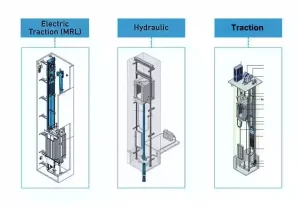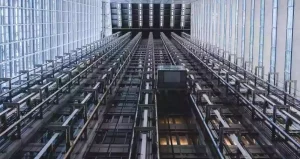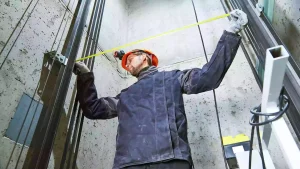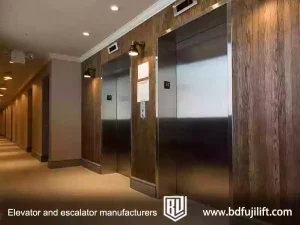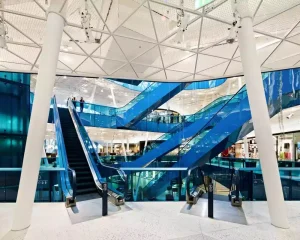To find the best and most affordable passenger lifts, you must understand how lift prices work. You also need to know what factors influence their cost.
Several factors affect a passenger lift’s price. These include the type of lift and its configuration. The brand also plays a role. Finally, the installation environment impacts the cost.
This guide will give you a clear overview of passenger lift prices for 2025. It will also share cost-saving strategies to help you stay within budget while meeting your needs.
Average Price of Passenger Lifts
When selecting a passenger lift, price is one of the most important considerations for every buyer. According to the latest market research data, the price of passenger lifts typically ranges from $20,000 to $150,000.
The price depends on the elevator type, the number of floors, the size, and the installation location.
Passenger Lift Price Range by Type
We researched popular passenger lift Type prices. We created a table to show the average costs.
| Elevator Type | Standard | Luxury | Custom | Average Price |
|---|---|---|---|---|
| Traction Lift | $28,000 – $50,000 | $60,000 – $100,000 | $100,000 – $150,000 | $50,000 |
| Machine-Room-Less Lift | $30,000 – $70,000 | $70,000 – $120,000 | $120,000 – $160,000 | $65,000 |
| Hydraulic Lift | $25,000 – $45,000 | $50,000 – $80,000 | $80,000 – $100,000 | $45,000 |
| Pneumatic Lift | $20,000 – $40,000 | $45,000 – $70,000 | $70,000 – $90,000 | $40,000 |
As shown in the table, there is a noticeable price difference between different types of passenger lifts. Traction lifts are generally more expensive. They cost between $28,000 and $150,000. These lifts offer better efficiency and a smoother ride. But, they need an extra machine room and more complex setups.
Hydraulic lifts, due to their simple drive system, are more affordable but are suitable only for low-rise buildings. Prices generally range from $25,000 to $100,000. MRL lifts don’t need a separate machine room. This gives you more flexibility during installation. They work well in places with limited space.Their price range is $30,000 to $160,000.
Passenger Lift Price Range by Floor
The number of floors directly impacts the cost, with each additional floor adding between $3,000 to $5,000.
Below is the price range for different floor levels.
| Specification | Hydraulic | Traction | Machine Roomless | Pneumatic |
|---|---|---|---|---|
| Three-Story Elevator | $15,000 | $18,000 | $20,000 | $22,000 |
| Four-Story Elevator | $18,000 | $22,000 | $24,000 | $26,000 |
| Cost of Each Additional Floor | $3,000 | $4,000 | $4,500 | $5,000 |
The price of an elevator rises as the number of floors increases. Elevators for taller buildings need stronger motors, control systems, and materials. These features add to the cost.
Passenger Lift Price Range by Size
The size of the elevator is another key factor affecting its price. The table below shows the prices for different elevator sizes based on the number of seats:
| Elevator Size | Hydraulic | Traction | Machine Roomless | Pneumatic |
|---|---|---|---|---|
| 4 Seats | $12,000 | $14,000 | $15,000 | $17,000 |
| 10 Seats | $15,000 | $18,000 | $20,000 | $22,000 |
| 12 Seats | $18,000 | $22,000 | $24,000 | $26,000 |
Passenger Lift Price Range by Region
The cost of an elevator can change a lot depending on where you are. In countries with higher labor costs, like the United States or Dubai, prices are usually higher. In places like the Philippines, where labor is cheaper, the price might be lower, but shipping and installation costs can still add to the total.
Below are the average prices for elevators in different regions. If you don’t see your region listed, feel free to contact us with your location and needs. Our engineers will give you a free quote.
| Region | Price (USD) | Local Currency Equivalent |
|---|---|---|
| United States | $15,000 – $50,000 | USD |
| Philippines | $10,000 – $40,000 | PHP 500,000 – 2,000,000 |
| Arabia | $12,000 – $45,000 | SAR 45,000 – 170,000 |
| Dubai | $14,000 – $50,000 | AED 55,000 – 185,000 |
These prices are rough estimates. The cost can change based on the type of elevator, the number of floors, and how complex the installation is.
How to Calculate the Price of a Passenger Lift?
To calculate the price of a passenger lift, you need to know the basic price, the floor increment, and the seat price. The formula is:
Total Price = Basic Price + Floor Increment + Seat Price
Example Calculation: 8-Floor, 6-Seats Traction Lift
-
Basic Price: For a 4-floor traction lift, the price is $22,000. Each additional floor adds $4,000. For 8 floors:
-
Additional floors = 8 – 4 = 4 floors
-
Floor increment = 4 × $4,000 = $16,000
-
Total = $22,000 + $16,000 = $38,000
-
-
Seat Price: The price for 6 seats is between the 4-seat and 10-seat prices.
-
4-seat price = $14,000, 10-seat price = $18,000
-
Difference = $18,000 – $14,000 = $4,000 for 6 seats
-
Price per seat = $4,000 ÷ 6 = $1,000 per seat
-
Total seat price = $14,000 + 2 × $1,000 = $16,000
-
-
Total Price:
-
The price for an 8-floor, 6-seats traction lift is $54,000.
-
The price of a passenger elevator can change based on factors like the type, number of floors, size, and location. To get an exact price, it’s best to contact an elevator company like BDFUJI.
BDFUJI uses advanced technology to make elevators. They offer good prices through an efficient sales system. They also work with well-known brands to provide high-quality elevators.
BDFUJI offers great after-sales service to keep your elevator safe and working well for a long time. Contacting them can save you time and help you get the best deal.
Additional Costs of Installing Passenger Lifts
In addition to the base price of the elevator, other installation-related costs must be considered:
-
Site Preparation: This includes any structural changes, such as reinforcing floors or creating space for the elevator shaft, which can increase costs.
-
Labor: Installation requires skilled labor, and the cost can vary depending on the region and complexity of the installation.
-
Maintenance: Ongoing maintenance is necessary to keep the elevator working well, and the cost varies based on the elevator type.
-
Permits and Fees: Local government regulations may require specific permits and inspections, which can add to the total cost.
Key Factors Affecting Passenger Lift Price
The price of a passenger lift is not only related to its type but is also influenced by several factors. Here are the main factors:
Lift Type and Design
As mentioned earlier, traction lifts are generally more expensive than hydraulic lifts. Custom lifts, due to the need for special designs and tailored solutions, are also priced higher.
Lift Capacity and Speed
The lift’s capacity and operating speed directly affect the cost. Larger lifts and faster lifts cost more. They need stronger drive systems. They also use more complex technology.
Material and Component Quality
Better materials and components increase the price. This includes control systems and safety devices. For instance, lifts made with heat-resistant, corrosion-resistant materials last longer. But, these materials also make the lift more expensive.
Installation Complexity
When an installation environment is complex, costs increase. This includes buildings with special structures or limited space. Custom solutions also drive up prices. So, complex conditions raise installation expenses.
Effective Strategies for Reducing Passenger Lift Installation Costs
During the installation of a lift, many clients face the issue of going over budget. To effectively save on costs, here are some strategies to consider:
- Choosing standard lift designs : Customized lifts cost more to design and build. They also take longer to deliver. Thus, pick a standard model for quicker, more affordable installation.
- Negotiate with suppliers : You can get a discount if you buy lifts in bulk. This saves you money on each unit. So, consider bulk purchasing.
- Optimize installation plans : Install the lift and finish all related work at the same time. This includes electrical connections and structural changes. Doing so prevents extra construction. It also helps you avoid unnecessary costs.
- consistent inspections : Regular maintenance prevents big problems. It also saves you money on repairs and replacements.
Common Pricing Misconceptions About Passenger Lifts
Does a Higher Price Mean Better Quality?
Many people believe higher-priced lifts are always better quality. But, this isn’t true. A higher price does not guarantee a superior product. So, don’t assume price equals quality.
High-priced lifts may only reflect a brand’s name. They might not offer better technology or quality. So, a higher price doesn’t always mean a better product.
When you pick a lift, focus on its performance and after-sales service. Do not just consider the brand name. These factors truly matter.
What Do Customers Often Overlook When Comparing Prices?
When you compare prices, remember long-term costs. Customers often overlook how much they pay to run and maintain a lift. These ongoing expenses add up significantly.
A cheaper lift might need more frequent repairs. This costs you more money over time.
It may cost more to buy an elevator that runs smoothly and has fewer problems. But your maintenance expenses will be reduced. So, the higher initial cost is more economical in the long run.
Real-World Results: Budget vs. Quality
We compared test results from various lift brands. Some famous brands cost more. Yet, their performance and maintenance weren’t always better than other valuable brands.
Electric lifts are complex systems. They are like computers, with many key parts. Often, both famous and lesser-known lift brands use the same components. The traction machine, control system, door mechanism, and electrical parts often come from the same suppliers.
Well-known lift brands often cost more due to their name and after-sales service. But, their core components are not much different from other brands.
Lesser-known brands invest less in marketing. Yet, they often use the same quality parts. They offer similar products at better prices through efficient operations.
Thus, focus on a lift’s actual performance, energy efficiency, and maintenance costs. Don’t just consider the brand name. This ensures you meet your needs without paying extra for a brand.
Final Thoughts
In lift procurement decisions, perceived value is far more important than the brand. A brand name suggests some quality, but a lift’s core technologies truly affect its performance. Consider BDFUJI lifts, for example. They offer advanced traction technology, smart control systems, and efficient energy management. This provides high-quality solutions and helps you avoid paying extra for just a brand name.
Recommended reading:
2025 Ranking of the World’s Best Passenger Elevator Manufacturers
Precautions For Purchasing Passenger Elevators
Passenger Elevator Dimensions (Car, Pit, Hoistway)
How to Determine The Size of The Passenger Elevator? The Most Comprehensive Guide
Service Elevators vs. Passenger Elevators:Which is Best for You?
FAQ
How much does a 6-passenger lift cost?
A 6-passenger lift usually costs $5,000 to $8,000. This applies to commercial buildings, homes, and offices.
How much does a lift for a six-story building cost?
A six-story building lift usually costs $60,500 to $175,000. This averages $180 to $350 per square foot. This price covers the lift itself, which runs from $50,000 to $120,000. Installation adds $10,500 to $45,000. You’ll also pay $1,500 to $3,000 for permits and cover building changes.
Do passenger lifts consume a lot of power?
A passenger lift’s power use depends on its type, building height, and how often people use it. For a 3-story building, hydraulic lifts can use up to 4,000 kWh yearly. In contrast, traction lifts typically consume 1,500 to 2,500 kWh.
Do I need a permit to install a passenger lift?
It depends on the size and scale of your project. Residential lift installations typically don’t need planning permits. But, commercial buildings usually do need them. Please refer to your local building regulations for more details.


